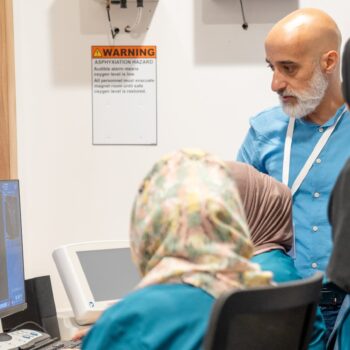The role of Physiotherapy in the management ofgynaecological cancers
Article: Noof Said Al Siyabi- a physiotherapist in the Department of Physiotherapy, and Gynaecological Program at the SQCCCRC. Dr. Ikram Burney – a Senior Consultant in Medical Oncology and the lead for the Gynaecological Program at the SQCCCRC.
Management of Gynaecological Cancers across the continuum of care – Part 5
This is the fifth of a series of several articles intended to increase awareness about cancers of the female genital tract and their management. Management of cancer can be seen across the continuum of care, from prevention, early detection, diagnosis, treatment and symptom management through survivorship. This article deals with the management of symptom related to Gynaecological Cancers using Physiotherapy
The role of Physiotherapy in the management of gynaecological cancers:
Physiotherapy focus on movement science helping individuals to maintain and maximize their physical strength, range of motion, functional and overall well-being. Also, physiotherapy interventions have been proven to be effective in addressing major complications of arising from gynaecological cancer, or its treatment. Furthermore, physiotherapy plays an important in the survivorship program of patients diagnosed with gynaecological and other cancers.
Physiotherapists play a critical role in improving the knowledge of patients about their symptom management, and engaging patient as partner in their care (Monteiro 2021). Physiotherapy interventions significantly improve physical function, and the quality of life of cancer patients and survivors (Shardeshu S 2022). One of the major roles of physiotherapy in gynaecological cancer is to increase the quality of life of patient during and after the treatment, making them more independent to carry out activities of daily living.
At the SQCCCRC, patients diagnosed with cancer receive care from a team of healthcare professionals including a physiotherapist amongst others. Within the first few days of diagnosis, the physiotherapist will make a subjective assessment and perform detailed physical examination to evaluate if the patient needs physical therapy interventions straightaway. In such a case, the patient will be seen during the admission to in-patient wards, or in out-patient department, the day care unit, or in the physiotherapy department. Th case will be discussed with the primary physician, and a joint care would be provided.
Patients with Gynaecological cancers may present with, or develop the following symptoms / complications:
- Pain
- Postural abnormalities
- Functional limitations
- Urinary incontinence
- Lower limb lymphedema
- Peripheral neuropathy
- Chest symptoms
- Post-operative complications
- Obesity or overweight at the time of diagnosis, or need to watch or reduce weight.
Pain, Postural abnormalities, and Functional limitations:
For patients presenting with pain and postural abnormalities, and functional limitations, the physiotherapist will assess pain intensity, severity, duration, and other symptoms, and make an objective assessment about posture, muscle strength, range of motion over joints, performance of functional activity, and the gait. Interventions include soft tissue releasing, muscle strengthening, muscle stretching, balance and coordination training, vestibular rehabilitation, joint mobilization, postural correction, or dry needling. These interventions will help the patient to increase joints range of motion, reducing pain, increasing mobility, maximising functional activity and enhancing quality of life.
Urinary Incontinence:
Urinary incontinence is defined as the involuntary leakage of urine, especially during coughing bouts. Urinary incontinence affects patient’s health and impairs quality of life. The prevalence of urinary incontinence in patients with gynaecological cancers is underestimated, as many patients do not inform health care providers of having this condition (Tran L and Puckett Y, 2022). The physiotherapist evaluates the pelvic floor muscle strength manually or via electrical device, and according to the level of weakness, the program is given including patient education, electrical muscle stimulation, vaginal cones, and strengthening exercises for the pelvic floor and the core.
Lymphedema:
Some patients may present with slowly progressive swelling of one leg, especially after surgery. This condition is called as lymphedema. Lymphedema result from accumulation of protein-rich lymph fluid in the lower extremity due to disruption of pelvic drainage after surgery. The condition may be associated with pain, feeling of heaviness, and difficulty in walking. Complex Decongestive Therapy (CDT) is a recent and a widely used intervention for the management of lymphedema. It is a combination of manual drainage, pneumatic compression using a machine, bandage, and exercises. Early prevention of CDT with rehabilitation exercises has been shown to be effective in reducing the incidence of lower limb lymphedema, reduced cancer-related fatigue, and improve patients’ quality of life (Wu 2021).
Prevention and management of surgical complications:
Physiotherapy plays a pivotal role in prevention of complications and management of symptoms after surgery for gynaecological cancers. Physiotherapy brings potential benefits on deep vein thrombosis formation, perioperative pain management, respiratory complications, bowel obstruction, lymphedema formation, early mobility, and quality of life. Early mobilization after surgery is highly recommended, as it increases patient independency and produces positive psychological effects. Some patients, especially after surgery present with reduced chest expansion, abnormal breathing pattern, reduced cough strength, and abnormal lung sounds. For such patients, interventions include exercises that regulate breathing pattern, maximise chest expansion, clearing the sputum, strengthening the muscles, and maintaining clear airways (Sehouli J, 2022).
Peripheral Neuropathy:
Patients with gynecological cancers who have concomitant diabetes mellitus, nutritional deficiencies, or are overweight, may experience neurological dysfunctions. Additionally, some chemotherapeutic agents cause peripheral nerve neuropathy. Abnormal sensation may be felt in the limbs while touching an object or even at rest. These include numbness, burning sensation, or stabbing pain. Motor nerve involvement may manifest as tremors or shaking of limbs, or weakness of the muscles responsible for limb movement. These symptoms can be managed by a variety of physiotherapy interventions. These include proprioceptive neuromuscular facilitation, resistance training, strengthening exercises, nerve tension, nerve gliding, spine, and limbs joints mobilization. These interventions are administered according to the severity and chronicity of symptoms. Physiotherapy sessions are usually commenced in the hospital setting and continued as home program. In addition, occupational therapist and the podiatrist provide education to the patient regarding limbs safety, for example, observing the limbs frequently, to make sure the limbs are in a good condition.
Obesity and overweight:
Around 75% of women with uterine cancer will be overweight (Body Mass Index > 25kg/m2, or Obese (BMI > 30kg/m2) at the time of diagnosis. Obesity is a risk factor for uterine cancer. More importantly, patients who are successfully treated for uterine or ovarian cancer are at an increased risk of cancer recurrence if they gain more weight. Hence, weight management is important, is a multi-disciplinary work, and requires cooperation from the patient as well as the health care professionals including physicians, dietitians, psychologist, and the physiotherapist. Physiotherapy targets the physical part that include increasing the level of physical activity safely and within individuals’ tolerance, keeping in view their medical condition. It starts by evaluation patient’s level of function, exercises tolerance, cardio-vascular fitness, muscle power, and screening for contra-indications. Ensuring safety is crucial part of the program. Physiotherapy intervention is planned according to the patient specific condition and needs, and the program starts under close supervision of physiotherapist to assess safety and body response to intervention, and continued at home. Interventions include behavioural modification, aerobic training, resistance training, strengthening exercises, and high intensity training.
In summary, physiotherapy interventions are provided throughout the cancer treatment journey and as part of the survivorship program. It is delivered as part of the holistic care to the patient, and addresses individualized needs aiming to treat the symptoms and complications of treatment, increase tolerance to treatment, enhance the quality of life, and reduce the chances of cancer recurrence.
References:
- Monteiro MGCT and de Morais Gouveia GP. Physiotherapy in the management of gynecological cancer patient: A systematic review. Journal of Bodywork and Movement Therapies, 2021. 28, pp.354-361.
- Shardeshu S et al. Role of Physiotherapy in Improving Lifestyle of Female Cancer Patients. J Drug Discov Develop and Deliv. 2022; 8(1): 1040.
- Tran LN and Puckett Y. Urinary incontinence. 2022. StatPearls [Internet].
- Wu X et al. Early prevention of complex decongestive therapy and rehabilitation exercise for prevention of lower extremity lymphedema after operation of gynecologic cancer. Asian Journal of Surgery, 2021; 44(1), 111-115.
- Sehouli J et al. Peri-operative ovarian cancer guidelines: prehabilitation, enhanced recovery, post-operative ileus prevention, post-operative physiotherapy and mobilization. International Journal of Gyn ecological Cancer, 2022; 32(10), 1341-1343.
- Survivorship care for healthy living. NCCN Guidelines for Patients Survivorship for Healthy Living. Accessed on July 11, 2023.





